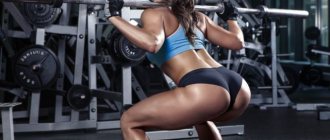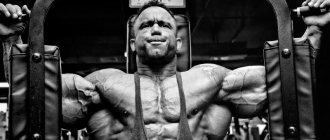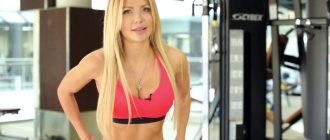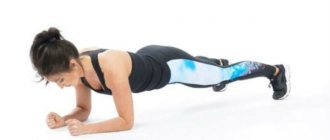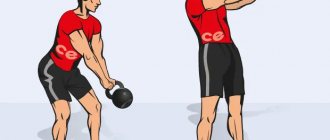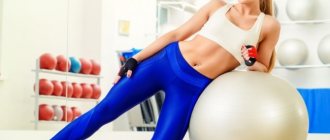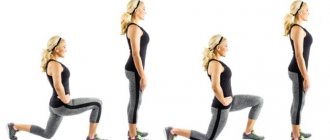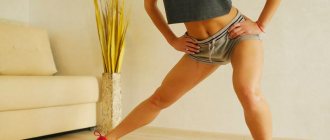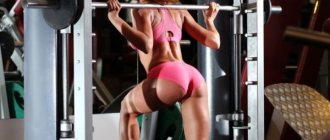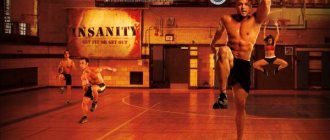If you manage to overcome the entire described complex, and bring the time spent in each position to a minute, then consider that you have conquered the vastness of static mastery for the hips and buttocks. Now you just need to not give up classes, add other options, increase “circles” and follow all the above tips. Six months - and you won’t recognize yourself!
Have you ever wondered why bodybuilders often have low endurance, and Olympic marathon runners cannot boast of sculpted muscles? Why do fitness masters have the most graceful figures, and why is the ageless Jackie Chan still the undisputed champion in the art of mastering one’s own body in world cinema? In this article we will look at 9 static exercises for losing weight on your legs, thighs and riding breeches. They will help you lose weight and develop muscle strength in your lower extremities.
A circular complex that will quickly get you in shape
What is the advantage of statics over dynamics? As you know, almost all physical training can be roughly classified into:
- Aerobic , in which importance is attached to the heart rate indicator, for example, exercise bike, aerobics, running, race walking, jumping rope.
- Stretching exercises - all kinds of leg stretches while sitting on the floor, twisting, splits.
- Dynamic. Dynamics – movement, that is, all exercises for repeating the same movement a certain number of times; for example, take regular squats.
- Static is training in which muscles work without moving parts of the body, and that’s what we’ll talk about.
Subscribe to our INSTAGRAM account!
And it is during static conditions that our muscles:
- They are subjected to maximum prolonged tension without the opportunity to relax, as is done in dynamics.
- Parts of the body in a static exercise are motionless.
- Static exercises performed at half strength are usually aimed at maintaining the weight of your own body in a certain position (classic “plank”).
- Static exercises, performed at full strength, are aimed at overcoming an obstacle (“moving the wall”).
- They are aimed at strengthening tendons, as opposed to dynamics, in which only muscles are developed.
- As a result, regular static exercises develop not so much muscle relief, but practical muscle strength (there is a classic example of a jock who is unable to unscrew the lid of a sealed jar).
- Due to the fact that in static training (but only those performed at half strength) predominantly red muscle fibers work, the main role of which is burning fat and producing energy, these exercises contribute to almost one hundred percent “drying out” of excess muscles, eliminating excess liquid and fat and giving, in the case of our topic, your legs and buttocks a perfectly elongated and elastic shape.
- In addition, it is the red fibers that are surrounded by a large network of capillaries, so their work increases the influx/outflow of oxygen in general, which has a beneficial effect on the blood supply to the muscle mass, as well as on the state of the cardiovascular system in general.
Benefits in strengthening lower body muscles
Of course, it is impossible to narrowly limit ourselves to the development of only one or several parts of the body, forgetting about the rest. An integrated approach to most training is built on this understanding.
However, it is necessary to point out the advantages in the development of the muscle groups of the lower body, in particular the legs and buttocks, over all others. It lies in their maximum “fat-burning” effect for long-term maintenance of ideal weight. But that is not all.
So, the leg muscles are the most voluminous muscles in the body of a normally developed person. Many physical indicators depend on how strong and massive they are: weight, endurance, as well as the speed of metabolic processes. Well-developed thigh muscles have a beneficial effect on the functioning of the excretory, reproductive, and even digestive systems. At the same time, they stand guard over the hip and knee joints. It’s worth reading separately about knee pain .
And the healthy condition of the knees, in particular, according to the Taoist teaching about “Walking on the Knees,” depends on the vital activity of the kidneys, and as a result, visual acuity, good condition of teeth, hair and even memory. It turns out that by training your legs, you are conducting a simultaneous therapy session for body organs that are so far removed from each other. And if the Chinese call the knees the “temple of tendons,” then the thigh muscles could rightly be called the “forge of health.”
About 6 incredible facts of Taoist “Walking on your knees”, see here.
So what are static loads on the legs and are they necessary? After presenting such facts, no one will doubt the enormous benefits of intensive work specifically on the leg muscles, to which the buttock muscles are automatically added. Because it’s paradoxical to imagine chiseled legs with flabby buttocks! In addition, the muscular ensemble of both the hips and buttocks is an integral part of the “core” muscles (from English - “core”) - the general basis of human strength.
A circular complex of 9 static exercises for the legs and buttocks
Let us immediately note that in order to achieve a full effect, most instructors advise taking a comprehensive approach to training. You are asked to perform the so-called “circle”. Its essence is the alternate static work of all the muscles of the buttocks and thighs by alternating various exercises with a minimum break (1-2 seconds) and a maximum duration of delays in each position. The latter depends on the degree of your preparedness, it can be from 5-10 seconds to a minute or more.
Side Lunge Stand
In fact, this is a frozen component of the well-known sailor dance “Apple”. From a standing position, you half-squat on one leg, moving the other to the side and pulling the toe toward you (the last nuance works the upper part of the inner thigh, you don’t have to pull the toe). The arms can be on the legs, on the waist, extended in front of you, and also closed behind the head (if you want to add a static effect for the muscles of the back, shoulder girdle and arms at the same time, then the last two positions are ideal). You freeze in this position for 5-10 seconds (more is better, a minute is ideal, even more - you are a Superhero!)
This pose is identical to regular dynamic side lunges, which, by the way, also work great on the gluteal muscles. The stand trains the muscles of the thighs (especially the inner surface) and buttocks and back.
Forward leaning stance
This pose is also called “Frozen Puppet”, or “Swimmer at the Start”. The target muscle group is the gluteal and posterior thigh muscles (biceps), as well as all the muscles of the body responsible for posture (core muscles).
From a standing position, with straight legs, back, arms (legs shoulder-width apart), we bend forward at a right angle to our legs. The arms continue the straight line of the body - extended forward. The chin is pulled forward.
Ballet stance
In this exercise you work all the muscles of the thighs, buttocks, and calves. It is no coincidence that it is the main one for ballerinas and balleros. From a standing position, with your feet wide apart and your heels turned towards each other, squat on your toes (heels raised as much as possible) until your thighs are parallel to the floor. In this case, the hips are separated as much as possible, and the back is kept straight. You can always achieve additional effects for the back, shoulders, arms and neck by adding complications in arm balancing.
The stance is identical to the dynamic plie squat, which itself perfectly works the entire lower body and removes fat between the legs.
Incomplete swallow
First of all, the posterior muscles of the thighs and buttocks are strengthened.
Description of the static pose standing on 1 leg “Swallow”: Standing (you can hold your hands on the back of the chair, since it is very important to keep your back straight), lift and move back one straight leg, to the maximum possible angle in which you can fixate. The exercise is done alternately for each leg.
Taking the leg forward
The same thing, but each leg rises in front of the body. Hold onto a wall or railing with your hand and keep your back straight. This exercise especially works the quadriceps and sartorius muscles, but all other muscles of the thighs and buttocks are also involved. A dynamic variation of the movement is to swing your leg forward.
It is also worth mentioning that all swings contribute to losing weight in the “ears” (breeches) on the thighs.
Important! Do not forget to pull the sock towards you - to tighten the problematic upper part of the inner thigh. And also do not move your leg to the side, which will reduce the load.
Subscribe to our Yandex Zen channel!
Exercise "Chair"
This classic exercise is a great circuit workout in its own right - but can also be part of a routine. Very useful for working the anterior thigh muscles, especially those located close to the knees, as well as the buttocks. An excellent static exercise to strengthen leg ligaments. Do it with your back against the wall, feet shoulder-width apart, feet parallel to each other.
We begin to squat, keeping our back pressed against the wall, until we reach a right angle at the knees. You can hold your arms along the wall for support, or you can stretch them out in front of you. After a delay, we straighten up just as slowly.
This exercise, along with the “plie” and “plank”, are basic and most effective in static exercises and together cover all muscle groups. In addition, they have many varieties, having studied which, you can gradually diversify your training.
Single leg plank
The exercise is difficult to perform at first. It simultaneously trains the muscles of the abs, arms, back, hips and buttocks, and in this variation the emphasis is especially placed on the last two groups, which is why we decided to include this exercise in the “circular” complex. Helps to lose belly fat.
From a lying position, stand on your toes and elbows, straightening your entire body in one line parallel to the floor. Having fixed yourself in this position, take one leg back and up, not forgetting to pull the toe towards you. Stay still for as long as you can, then switch legs.
Reverse plank
This exercise is not suitable for beginners; in addition, in addition to a strong core, it requires significant stretching of the arms. The fact is that the fingers of the palms should be turned exactly towards the toes, and this despite the fact that the hands are behind the back and support the whole body!
The reverse plank ideally strengthens all the muscles of the body, but the main “workhorses” are the posterior muscles of the thigh, calves, buttocks, shoulder girdle and back. In addition, it is excellent for stretching the shoulders and arms.
Lie on your back, point your toes out and place your feet next to each other on the floor. At the same time, pull your arms straight under your shoulder blades and press your palms to the floor in a straight forward direction. These are your four pillars. Now slowly rise up until your arms are completely straight behind your shoulders. Keep your back, buttocks and legs absolutely straight.
A little static-dynamic leg training - squats
For variety, complete your “circle” with one of the static-dynamic exercises. In static dynamics, the exercise is performed with the smallest amplitude and with an increased frequency of movements. This creates an even greater load on the supporting muscles of the exercise, since dynamic work occurs without the opportunity to relax. Do, for example, a static-dynamic squat.
Feet shoulder-width apart, back straight, arms extended forward. Lower yourself into a half-squat position and immediately begin to straighten up, but do not complete the movement, but lower yourself back into a squat, and so on. Keep your back straight, your abs tense, and your arms in front of you or behind your head. The feet are parallel to each other and do not come off the floor. With this exercise, you create the most intense load for all the muscles of the thighs, buttocks, calves, as well as the back, arms and neck. Performs within 30-60 seconds.
Contraindications
Like any exercise therapy complex, crocodile exercises also have their contraindications:
- serious back injuries, accompanied by compression fractures or displacement of the vertebrae, inflammatory processes in the tissues, edema;
- exacerbation phase of chronic diseases;
- the presence of malignant tumors or their metastases in the spine;
- acute peptic ulcers;
- bronchial asthma and pulmonary tuberculosis;
- severe pathologies of the cardiovascular system.
One of the contraindications to exercise is pulmonary tuberculosis
During the recovery period after surgery or recent serious illnesses, classes should also not be carried out until the health condition improves. In case of vertebral artery syndrome, problems with blood pressure and respiratory organs, it is recommended to perform exercises only with the permission of a doctor. Those with vertebral instability and people with osteoporosis should exercise with caution, as any sudden effort can lead to negative consequences.
Important! Pregnant women suffering from back pain can only perform certain exercises from this complex, but only until 8-10 weeks, and only if the doctor allows it. From the third month it is better to switch to special gymnastics for pregnant women.
How to properly perform a circuit complex
- “Circles” of static exercises should be repeated every other day, alternating them with training of any other type, but preferably aerobic or stretching (or you can alternate both).
- The primary complex for weight loss is designed for 2-3 months (depending on your individual characteristics, as well as on how correctly you create a psychological mood in yourself, adjust your diet, water balance, and alternating training with rest, and of course from your initial condition!).
- After completing the course, you should replace it for six months, for example, with daily aerobic training (can be alternated with stretching training), and then conduct at least another 2-3 month course of static exercises to consolidate the result.
- The number of “circles” increases as you progress: in the first week - one, in the second - two, in the third - three, and so on. At a minimum, this figure should be brought to 4-5.
- Before starting the exercises, you need to do a warm-up (vigorous walking in place, then running or jumping rope until the muscles are well warmed up).
- Between laps it is very important to do small stretching warm-ups.
- During exercises, it is necessary to monitor the correct breathing, do not hold it, do not knock it down (for the correct process of blood supply and oxidation in the muscles).
- After a repeated course of consolidation, you can alternately include certain exercises in complexes of exercises, which can be performed no more than 2-3 times a week. Our wise body, taught by the previous intensive, will “get it” on its own on the remaining days.
What are Crocodile exercises?
“Crocodile” is a set of twelve exercises based on twisting and stretching of the spine with mandatory breathing control. It is performed at a calm pace, does not require excessive physical effort, and has no age restrictions. Indications for these exercises are:
- chronic back pain;
- osteochondrosis;
- intervertebral hernia and protrusion;
- radiculitis of the cervical and lumbosacral region;
- sciatica.
Also, this complex is indicated for those who move little, have a sedentary job, or, conversely, are forced to subject the spine to heavy loads. Noticeable relief occurs after the first sessions, and a sustainable therapeutic effect is felt after approximately 15-20 days of regular training.
Why are the exercises called Crocodile?
A little more about the benefits of statics
The enormous importance of static gymnastics was spoken about at the beginning of the 20th century by “Iron Samson,” or rather, Alexander Zass, a domestic classic of bodybuilding and the founder of isometric gymnastics. According to him, it is better to have strong arms than big muscles . He drew the attention of athletes to the fact that often, in a reckless desire to acquire powerful biceps, athletes lost control over them. That is, in essence, the muscular relief became a useless landscape on the human body, which he was unable to use.
Subscribe to our VIBER channel!
Indeed, do we rarely see people with outwardly pumped up body parts, but unable to do even 5 pull-ups? The fact is, as Alexander Zass taught, that it is not the muscles themselves that are responsible for the real strength of a person, or rather not their middle parts, but the tendons with which these muscles are attached to the bones .
By the way, anatomically, any muscle consists of a central part (active) - the “abdomen”, and passive endings (tendons), with which it is attached to the bones on both sides.
So, it is the degree of development of the tendons that determines how fully a person can use the active part of the muscles, since they set the latter in motion.
Imagine an emaciated beast of burden harnessed to a railroad trailer. Will it be able to move it? The answer is obvious.
Tendons are the motor force of your musculoskeletal system, and it was the need for their development that the great contemporary of our great-great-grandmothers spoke about .
In this article we are talking about static exercises performed at half strength, which develop red muscle fibers, facilitating weight loss and good blood supply to the muscles. In contrast, the isometric complex, following the example of Alexander Zass, affects white fibers, the percentage predominance of which is observed in sprinters and weightlifters. These fibers are also called “fast fibers” because of their ability to contract quickly, but they do not have long-term endurance. That's why sprinters run short distances!
Let's talk about red fibers. They are physiological antonyms of whites, which is why they are called “slow”, due to their inability to rapidly contract. But thanks to them, athletes achieve high levels of endurance. Practitioners of sports in which endurance is important have a predominant number of red muscle cells.
